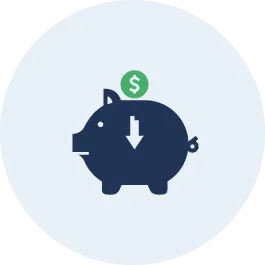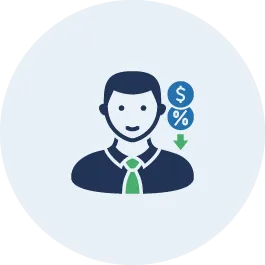Steps for Planning Your Retirement
A financially secure retirement needs a solid plan well before you want to retire. You may not want to stop working or think about a phased approach. You may not be able to rely fully on Social Security, so thinking ahead is key. Retirement planning has several steps, with the end goal of having enough money to stop working.

When Should You Start Retirement Planning?
The earlier you start planning and saving, the more time your money has to grow and build wealth. It’s never too late to start retirement planning, so even if you haven’t considered retirement, every dollar you can save now will be much appreciated later. Strategically investing could mean you won't be playing catch-up for long.
How Much Money Will You Need to Retire?
To know the amount of money you need to retire look at your current income and expenses, and how you think those expenses may change in retirement. Consider what in your life you'd still like to keep, such as vacations and dinners out, as well as what costs might continue, such as car and home maintenance costs. The typical advice is to replace 70% to 90% of your annual pre-retirement income through savings and Social Security.
What Are Your Financial Planning Goals?
Retirement is probably not your only savings goal, especially when you are younger. Lots of people have financial goals that are more of a priority, such as paying down credit card or student loan debt or building up an emergency fund. Save for retirement while you're building your emergency fund — especially if you have an employer retirement plan that matches any portion of your contributions.
What’s the Best Retirement Plan For You?
A key step of retirement planning is determining not only how much to save, but also where to save it. There is no single best retirement plan, but there is likely a retirement plan or combination of retirement accounts that will work best for you. Look for plans that provide tax advantages, and, if available, an additional savings incentive, such as matching contributions. That's why, in many cases, a 401(k) with an employer match is the best place to start for many people. If you don’t have a workplace plan, you can start up a similar plan such as an individual retirement account (IRA).
Types of Retirement Plans
Traditional IRAs allow you to make tax-deferred investments to provide financial security when you retire. There are other types of IRAs that might work for you. Another common IRA is the Roth IRA which is a tax-advantaged personal savings plan where contributions are not deductible but qualified distributions may be tax free. While you don't get a tax break up front, your contributions and investment earnings grow tax-free.

Employer-sponsored retirement savings plans are commonly offered as part of a job benefits package. Depending on what kind of organization you work for you may be offered a different type. The common names and numbers of these plans refer to sections of the IRS tax code. A 401(k) is a type of qualified profit-sharing plan that allows employees to contribute a portion of their wages to individual accounts. You can choose to have a percentage of your paycheck deposited into this account which is excluded from your taxable income. Employers can contribute to employees’ accounts and will sometimes match contributions. Public schools or non-profit organizations will offer a similar plan called a 403(b) plan. The investment options within the plans may vary, but the tax benefits are similar.

A governmental plan is an IRC Section 401(a) retirement plan established and maintained for the employees of the United States or its agencies. If you work for a sate or local government entity, you may be offered a 457(b) plan. These plans work similarly to other employer-sponsored plans.

A defined benefit pension plan is a retirement plan that promises a pre-determined specific monthly benefit or lump sum to an employee upon retirement. The benefit is based on the employee's earnings history, age, and years of service, rather than on how well individual investment returns do.

Retirement Plan Fees and Expenses

There are a variety of plan fees and expenses that may affect your retirement plan. It's important to understand your plan's fees and expenses because they are one of the factors that will affect your investment returns and impact your savings available at retirement. While the contributions you make to your account and the earnings on your investments will increase your retirement income, fees and expenses paid by your plan may substantially reduce the growth in your account, which reduces your savings available at retirement. The most common fees and expenses are plan administration fees, investment management fees and individual service fees.
Frequently Asked Questions
Deciding when to start receiving Social Security retirement benefits is one of the most important decisions you will ever make and depends heavily on your circumstances. You can start collecting benefits based on your work history as early as age 62, or sooner if you are disabled, or wait until your full retirement age. The most important thing is to make an informed decision. Base your decision about when to apply for benefits on your personal and family circumstances.
Your Social Security Statement is available to view online by opening a my Social Security account. This statement lists your projected benefits between age 62 to 70, assuming you continue to work and earn about the same amount through those ages. Remember, the Social Security Administration (SSA) base your benefit payment on how much you earned throughout your working career.
You can apply for retirement benefits up to 4 months before you want to start receiving your benefits so you can avoid a gap in income. For example, your first check will not arrive until the month after the one you pick in your application.
The most convenient way to apply for retirement benefits is by completing the online application. You will need to create or log in to your personal my Social Security account. You can also apply by directly calling the Social Security Administration at 800-772-1213 (TTY 800-325-0778), Monday through Friday from 8:00 a.m. to 7:00 p.m. local time or visiting your Social Security office.
You cannot keep retirement funds in your account indefinitely. You generally have to start taking withdrawals from your IRA, SIMPLE IRA, SEP IRA, or retirement plan account when you reach age 72 (73 if you reach age 72 after Dec. 31, 2022). Your required minimum distribution is the minimum amount you must withdraw from your account each year. You can withdraw more than the minimum required amount. Your withdrawals will be included in your taxable income except for any part that was taxed before (your basis) or that can be received tax-free (such as qualified distributions from designated Roth accounts). For more information visit www.irs.gov.
A postponed retirement, sometimes called a phased retirement, can be used to increase your retirement savings by adding to your savings, but also by delaying the need to access your retirement savings. However, delaying your retirement may not be an option for you due to health-related work limitations, caregiving responsibilities, or a forced early retirement. Depending on your retirement planning, if you are able to delay your date of claiming Social Security, the retirement benefits are increased by a certain percentage (depending on date of birth) if you delay your retirement beyond the full Social-Security-Administration -defined retirement age. The benefit increase no longer applies when you reach age 70, even if you continue to delay taking benefits.